Thelocactus Britton & Rose, Bull. Torrey Bot. Club 49: 251 (Aug. 1922).
Basionym: Echinocactus subg. Thelocactus K. Schum., Gesamtbeschr. Kakt.: 429. 15 Apr 1898.
Type: Echinocactus hexaedrophorus Lemaire.
Synonyms: Thelomastus Frič, in Kreuzinger, Verzeichnis 10 (1935), nom. illeg. Torreycactus Doweld, Sukkulenty 1: 19 (1998).
Stem single or clustering, depressed, globose, ovoidal or cylindrical, 3-40 cm tall, 2-20 cm wide. Ribs distinct or indistinct. Tubercles present, rounded to conical. Areoles at the apices of tubercles, sometimes elongated into a short groove, with or without glands. Spines usually straight, variable in diameter, length and colour; radial and central spines generally distinguishable. Flowers apical, funnel-shaped, with a scaled ovary and tube, white, yellow, magenta or rarely orange to red. Fruits greenish to reddish, with the perianth remnants persistent, scaly, dehiscing at maturity by a basal pore. Seeds pyriform, with a basal hilum, black; testa cells tabular, convex or conical, outer periclinal wall with a verrucose microrelief or smooth.

The neotype of Echinocactus hexaedrophorus Lemaire
From: C. Lemaire, Iconographie descriptive des Cactees, Plate 2 (Dec. 1841).
Image courtesy Missouri Botanical Garden. Botanicus Digital Library
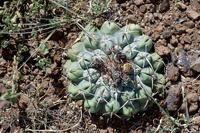 Thelocactus hexaedrophorus
Thelocactus hexaedrophorus
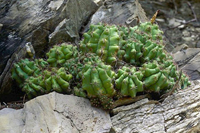 Thelocactus leucacanthus ssp. schmollii
Thelocactus leucacanthus ssp. schmollii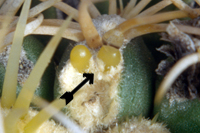 Thelocactus bicolor ssp. schwarzii
Thelocactus bicolor ssp. schwarzii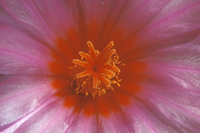 Thelocactus bicolor
Thelocactus bicolor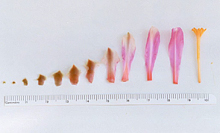 Thelocactus bicolor ssp. heterochromus
Thelocactus bicolor ssp. heterochromus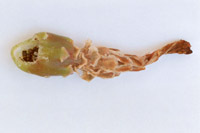 Thelocactus bicolor ssp. heterochromus
Thelocactus bicolor ssp. heterochromus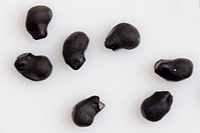 Thelocactus buekii
Thelocactus buekii